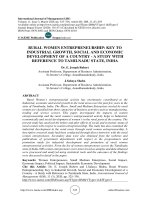Economic growth and economic development 397
Bạn đang xem bản rút gọn của tài liệu. Xem và tải ngay bản đầy đủ của tài liệu tại đây (155.42 KB, 1 trang )
Introduction to Modern Economic Growth
and substituting for c (t) into this lifetime budget constraint in this iso-elastic case,
we obtain
(8.19) Z
c (0) =
ả ả
à à
á
Z
(1 ) r (t) ρ
− + n t dt a (0) +
exp −
w (t) exp (− (¯
r (t) − n) t) dt
θ
θ
0
0
as the initial value of consumption.
∞
8.2.3. Equilibrium Prices. Equilibrium prices are straightforward and are
given by (8.5) and (8.6). This implies that the market rate of return for consumers,
r (t), is given by (8.8), i.e.,
r (t) = f 0 (k (t)) − δ.
Substituting this into the consumer’s problem, we have
1
c˙ (t)
=
(f 0 (k (t)) − δ − ρ)
(8.20)
c (t)
εu (c (t))
as the equilibrium version of the consumption growth equation, (8.14). Equation
(8.19) similarly generalizes for the case of iso-elastic utility function.
8.3. Optimal Growth
Before characterizing the equilibrium further, it is useful to look at the optimal
growth problem, defined as the capital and consumption path chosen by a benevolent
social planner trying to achieve a Pareto optimal outcome. In particular, recall that
in an economy that admits a representative household, the optimal growth problem simply involves the maximization of the utility of the representative household
subject to technology and feasibility constraints. That is,
Z ∞
exp (− (ρ − n) t) u (c (t)) dt,
max∞
[k(t),c(t)]t=0
0
subject to
k˙ (t) = f (k (t)) − (n + δ)k (t) − c (t) ,
and k (0) > 0.1 As noted in Chapter 5, versions of the First and Second Welfare
Theorems for economies with a continuum of commodities would imply that the
solution to this problem should be the same as the equilibrium growth problem of
1In
the case where the infinite-horizon problem represents dynastic utilities as discussed in
Chapter 5, this specification presumes that the social planner gives the same weight to different
generations as does the current dynastic decision-maker.
383









